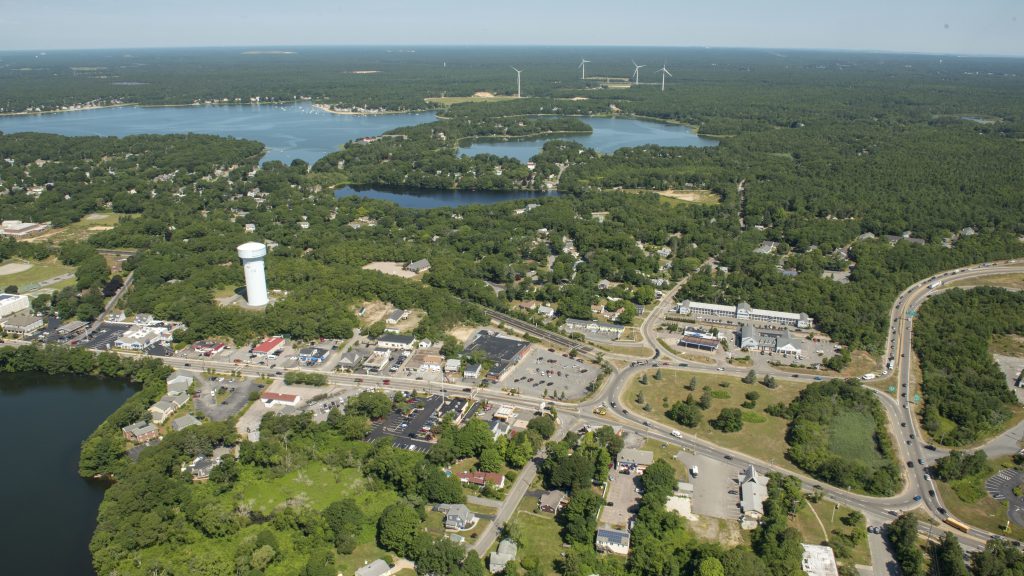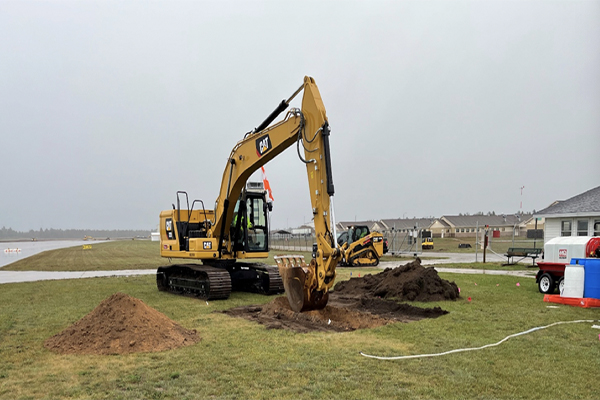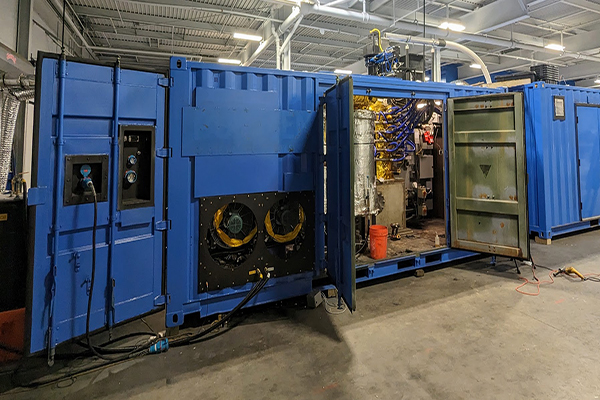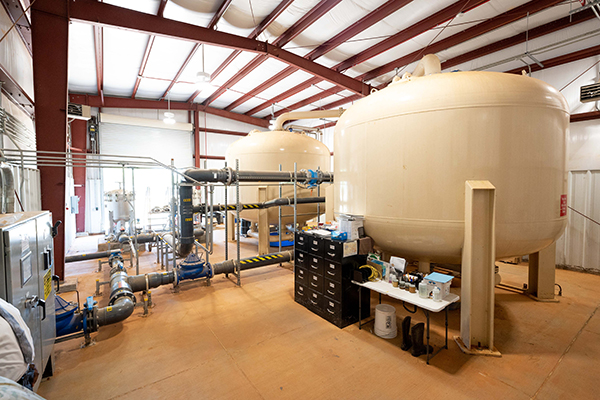
By Richard Higgins, Sc.D.
The prevalence of per- and polyfluoroalkyl substances (PFAS) in the soil and groundwater on military bases continues to be a preeminent concern of defense leadership, and the impacts to personnel and local communities over the years are widespread. Some of the most pressing concerns surround impacted water that migrates underground, perhaps contaminating drinking-water wells near installations.
While the reality of per- and polyfluoroalkyl substances in the soil and groundwater on military bases is a safety and environmental concern, a growing number of emerging technologies may help in addressing this evolving issue.
The urgent need to address the health effects from PFAS has led to a fast-growing toolbox of methods and technologies that can help begin managing the problem. A class of manufactured chemicals, PFAS have been widely used in fire-fighting foam, breathable outerwear including some uniforms, de-greasing compounds, as well as fast-food packaging and many other products.
The Department of Defense (DOD) has clearly stated that the scope of the PFAS problem, based on what is known today, will take years to define the full scope of cleanup and decades before it is complete. Through March 31, 2023, DOD has determined that 707 military properties (including active installations, BRAC locations, National Guard facilities, and Formerly Used Defense Sites) require an assessment of PFAS use or potential release. Preliminary Assessments/ Site Inspections have been completed at 425 locations, with a determination of no further action needed for 103 locations.
The remaining 322 assessed sites are proceeding to the next step in the CERCLA process, which is remedial investigation, before determining appropriate cleanup actions based on risk.
SCOPE OF THE PROBLEM
Among the major sources of PFAS contamination on military bases is aqueous film-forming foam (AFFF). Consequently, firefighting practice areas are the sites where frequent use of AFFF over the years may have resulted in a plume of contaminated groundwater that has spread long distances beyond the base’s property line. Other contaminant sites are often found on flight lines, typically from aircraft crashes or hard landings.
Groundwater contamination can even be found in non-locations, the result of isolated incidents over the years. At a project site in New England at Joint Base Cape Cod (see sidebar), a PFAS hot spot was found from fighting a ground vehicle fire at a tanker truck rollover site.
Finding PFAS hot spots begins with consulting current personnel about the history of the base: the location of firefighting practice areas and other firefighting facilities; previous buildings that may have been the scene of AFFF usage, or storage sites that may have been the scene of a fire. Importantly, however, teams often need to go beyond human memory, to consulting old site plans, historic aerial photos, satellite images, and other sources to get the full picture.
Within the Department of the Air Force, where many of the military sites afflicted with PFAS are, the Air Force Civil Engineer Center (AFCEC) often takes the lead not just with the “detective” work to find PFAS sites, but as a “doctor” to help plan a way forward, working with engineering and environmental firms. Industry contractors may be of great use in executing environmental remedial investigations and actions on behalf of AFCEC and demonstrating to the surrounding community that the base is taking a proactive approach to protecting them and their health. Public outreach tackling the multifaceted problem that is PFAS.
FAST-IMPROVING INDUSTRY
Being able to solve the PFAS puzzle from a technical standpoint is only part of the equation; the sheer volume of groundwater involved—and the expectations around the tolerances to be met—is equally challenging. There may be millions of gallons of groundwater to be pumped from the ground and treated, right down to PFAS concentrations in parts-per-trillion.
The urgent need to address the health effects from PFAS has led to a fast-growing toolbox of
methods and technologies that can help
begin managing the problem.
The emerging picture for PFAS removal is that of a two-stage process. The first is to reduce the scope of the problem by removing the chemicals from the impacted water and concentrating the PFAS-containing liquid so that the volume to be treated is manageable. The second is to destroy the PFAS molecules in that concentrate (to “mineralize” them), breaking them into constituent atoms or benign molecules.
Additionally, in a military context, the technologies employed to remediate PFAS-impacted soil and groundwater ideally should be completed on site so that no waste product is allowed to leave the gate. This increases protection for the surrounding public from health risks, as well as liabilities that may come from problematic waste being deposited elsewhere, outside the military’s control.
CONCENTRATION TECHNOLOGIES
A series of possible ways to concentrate PFAS-laden groundwater are available to military bases and environmental remediation experts.
Foam fractionation. This technology uses the surfactant qualities of PFAS, which make them so useful, to remove them from water. Foam fractionation involves releasing bubbles of air from below the water to be treated. The bubbles naturally move to the surface. On the way, the surface-active molecules, including PFAS, attach themselves to the gas-liquid interface of the bubbles, rising to form a foam on the liquid’s surface. This foam can then be skimmed off and isolated.
INNOVATIVE APPROACH
Applying new technologies in the field is a vital step toward making them practical. The U.S. Air Force is helping make this happen by funding a Phase II research contract with Onvector LLC, for using plasma vortex technology to destroy PFAS in groundwater extracted from
Joint Base Cape Cod, Mass.
For several decades, the installation has had a program for reducing soil and groundwater contamination, originally focusing on hydrocarbons. In recent years, the focus shifted to PFAS as understanding of the hazards of these “forever chemicals” grew. Much of the PFAS came from historical use of fire-fighting foams. The PFAS compounds in the discharged suppressant have migrated into the aquifer underneath the base,
which serves as a source of drinking
water for neighboring communities.
In particular for this project, base leadership wanted to find a solution that worked on site and did not involve taking any waste product off the base.
A pilot system was used to remove PFAS from groundwater at Joint Base Cape Cod’s fire training area, using regenerative ion exchange. This met all regulatory requirements, including those from the Massachusetts Department of Environmental Protection, but resulted in highly concentrated PFAS waste. The question then was how to destroy the PFAS waste without carrying it outside the fence line. In 2023, the base implemented the plasma vortex technology for final destruction of the PFAS.
The results met requirements.
Typical energy utilization rates were between 2,000-kWh/kg to 3,000-kWh/kg. The typical PFAS mineralization rates for the pilot system were between 3-g/hr to 5-g/hr of PFAS per hour of treatment time. The second-generation augmented Dual-Plasma system used at the base is
designed to achieve PFAS concentration levels of single ng/L or “non-detect” without high
energy use or operating costs.
Ion exchange. This method uses ion exchange resins made of highly porous, polymeric material. The internal porous surfaces of the resins contain highly polar (charged) bound chemical groups that will attract molecules having opposite charge. PFAS molecules, holding a negative charge, are attracted to anionic exchange (positively charged) resins, from which they can be removed for treatment. Various forms of ion exchange are currently being tested.
Reverse osmosis. This technique involves using pumps to push the liquid up against a semi-permeable membrane. Water molecules are small enough to slip through the membrane, while larger contaminant particles and molecules (including PFAS) stay on the “concentrate” side of the barrier. While reverse osmosis is used to treat landfill leachate, it has not yet been proven practical to work on impacted groundwater.
DESTRUCTION TECHNOLOGIES
Destroying the PFAS molecule (breaking it into its constituent atoms) is particularly challenging because it requires breaking the carbon-fluorine bond, one of the strongest known to molecular science. Some promising methods for PFAS destruction have been tried at bench-scale and pilot-scale; fewer, however, have been developed to be ready for commercial use.
Incineration. While incineration has been tried, its success has been found wanting. Use of this method has found that not all PFAS molecules get destroyed, and/or harmful byproduct molecules are formed. There is less use of incineration for PFAS destruction these days because of this, as it risks simply spreading the problem up the stack and further afield.
Plasma. This technology destroys PFAS molecules by harnessing plasma. Within the plasma vortex reactor, a voltage gradient is applied between two electrodes through an external power supply. This creates an electric field that strips electrons from the inflowing gas molecules, creating charged ions and releasing a plasma discharge. The ions, which are charged particles, are highly chemically reactive, and are capable of breaking down PFAS molecules. This breaks down the chemicals into harmless byproducts like fluoride, sulfate, carbon dioxide, and water.
Supercritical water oxidation. Water above 705°-F and pressure of 221.1-bar is considered “supercritical,” a special state where chemical oxidation processes are accelerated. It may be that supercritical water oxidation (SCWO) will prove a practical way to destroy PFAS by breaking the strong carbon-fluorine bonds and decomposing the material into a non-toxic waste stream. Like many technologies for destroying PFAS, it has been shown to work, but the next step will be showing that it can do this reliably and cost-effectively. SCWO is a tested and mature technology, but systems are expensive to build and have high energy utilization due to the required high temperatures. They are prone to corrosion and plugging when used for briny liquids, including PFAS concentrate streams. A variation on SCWO is hydrothermal alkaline treatment, which involves adding alkaline material to the PFAS concentrate. This involves lower temperatures and pressures than SCWO, but these systems have some of the same disadvantages for PFAS destruction.
Electrochemical oxidation. This is a water treatment technology that uses electrical currents passed through a solution, such as PFAS-containing water, to oxidize pollutants. Advantages of electrochemical oxidation include low energy costs; operation at ambient conditions; the ability to be in a mobile unit; and no requirement for chemical oxidants as additives. Conversely, limitations of the technology include difficulty to scale up to commercial volumes; the potential generation of toxic byproducts; incomplete destruction of some PFAS; efficiency losses due to mineral build up on the anode; the cost of electrodes; and potential volatilization of contaminants.
LOOKING AHEAD, CAUTIOUSLY
In 2022, the Environmental Protection Agency proposed that two types of PFAS (PFOS and PFOA) be designated as hazardous substances under the Superfund Program. This designation would increase transparency around releases of these chemicals and help hold owners accountable for cleaning up their contaminations.
The PFAS problem has reached a point where the technologies are coming online that can start to potentially help address the contaminations—but each of the approaches still has to prove that it is capable at scale, or is affordable, in order to truly be confident in the way forward. This ever-evolving field will continue to demand attention from science and industry.
Richard Higgins, Sc.D., is Chief Technology Officer, Onvector LLC; rjh@energyonvector.com.
More News from TME
-

Eliminating PFAS Leaching at Camp Grayling
At Camp Grayling, a novel colloidal-activated carbon material was used as a horizontal barrier on a site where aqueous film-forming foam had previously been discharged to prevent PFAS from leaching into groundwater. -

Reaching Sustainability Goals with Waste-to-Energy
The U.S. Army Engineer Research & Development Center’s Construction Engineering Research Laboratory is working to develop small-scale waste-to-energy systems that will advance installation sustainability and waste management. -

Investigating Emerging PFAS Destruction Technologies
Following recent interim guidance from the Department of Defense on how military organizations are to handle the destruction and disposal of PFAS, developing technologies that target the destruction of these forever chemicals hold possibilities for effective and efficient removal.